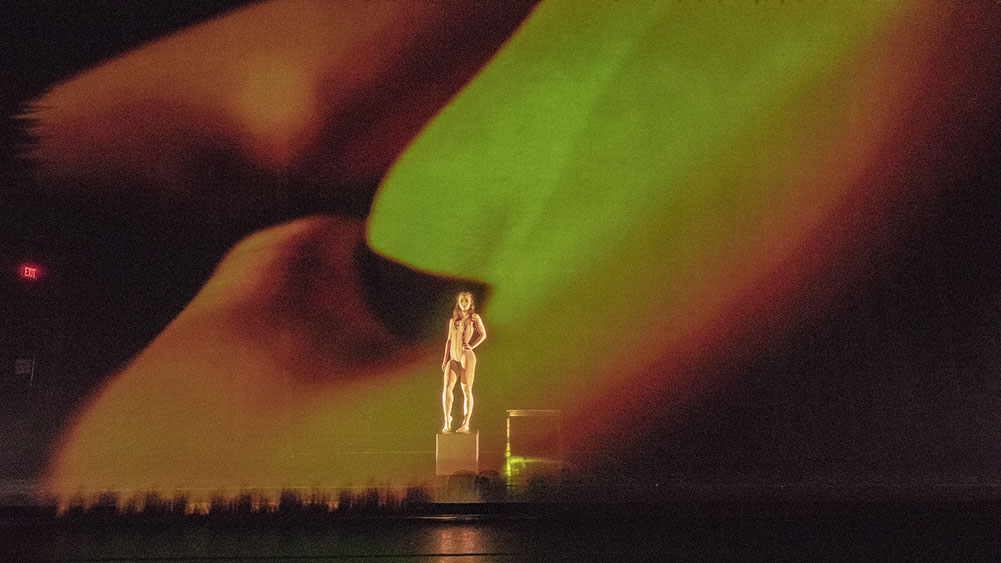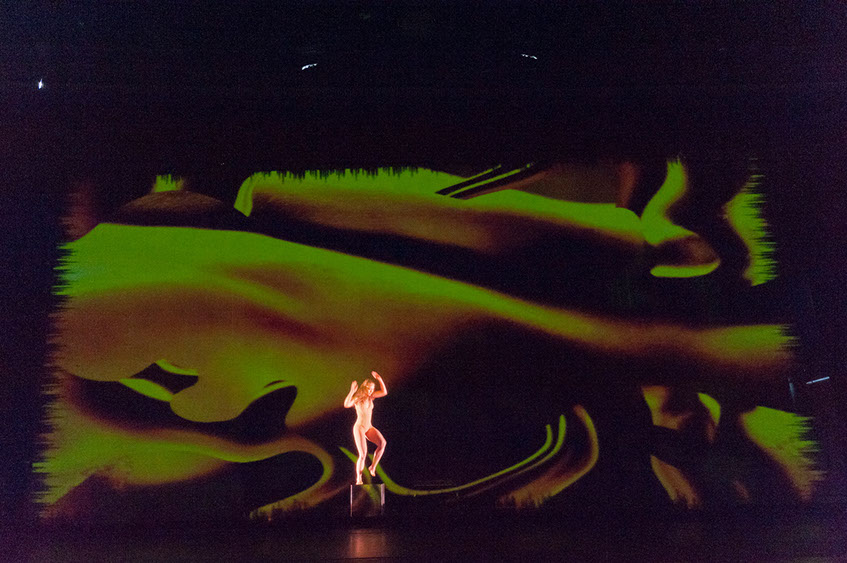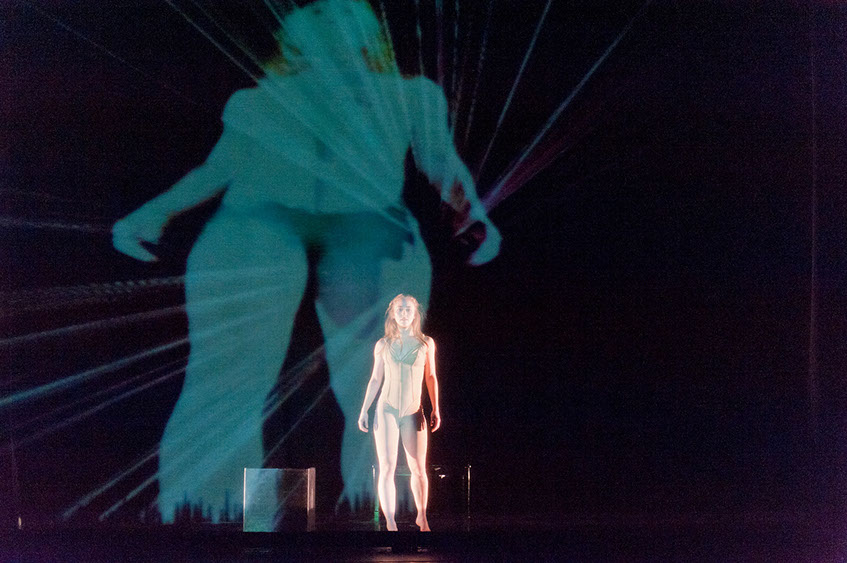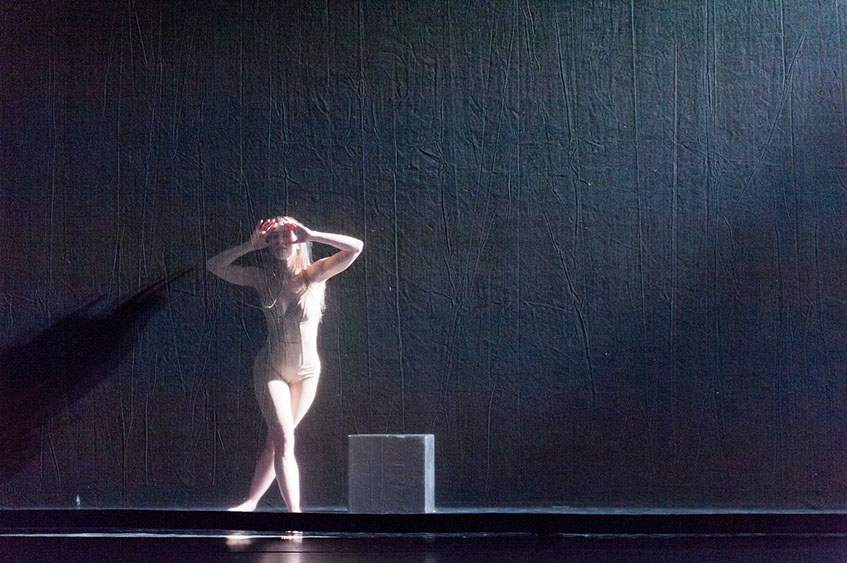Daniel Fine
Theatre Arts | Dance | Public Digital Arts
Tenure Dossier
Belladonna
Digital Media and Dance
Digital Media Designer, Set Designer
Role:
Peer-Reviewed Outcomes/Dissemination:
April 2018
Performance: Space Place Theatre, University of Iowa, Iowa City, IA
October 2018
Solo Conference Presentation: The Art of Content Creation
LDI 2018 Conference and Tradeshow. Las Vegas, NV
March 2019
Solo Conference Presentation: From Artistic Inspiration to Final Design
USITT 19 Conference & Stage Expo. Louisville, KY
Photo Gallery:









Projection mapped to dancer's body using Kinect Sensor.
Projection on scrim.
Projection on scrim.
Projection on scrim.
Projection on scrim - the body starts to melt.
Projection on scrim - displacement of the RGB camera - controlled by dancer and designer in real time.
Projection on scrim - displacement of the RGB camera - controlled by dancer and designer in real time.
Dancer discovers she can control her image.
Dancer discovers scrim - projections disappear.
9 - 9
<
>
Video:
Link to: Video of presentation at LDI. (Note: I discuss multiple projects on this solo panel talk.)
Key Creative Team:
Choreographer/Performer/Sound Design/Costume Design | Arianna Russ
Photographer | Dana Keeton
Lighting Design | Jeff Crone
Program Notes:
We recognize that it is our responsibility to acknowledge the predicament of unequal power dynamics between men and women that are often found in art and dance-making. While the concept, artistic decision-making, and digital design of Belladonna has been a truly collaborative effort, we acknowledge the complicated relationship that often arises in the projection of male-referenced ideology and creative content onto women's bodies. We believe it is our obligation as informed, empathetic and progressive creatives, to present work that not only acknowledges, but also helps to shift the paradigms that govern the experience of marginalized individuals.
About:
Belladona was a collaboration with MFA dance student Ari Russ for her thesis show and the culmination for her Digital Scholarship & Publishing Studio Summer Fellowship award for motion capture and solo dance performance (for which I also served as her advisor). It was also the culminating performance for a 2017 Old Gold Summer Fellowship Award, a developmental program for probationary tenure-track professors, that I received from the University of Iowa.
Since my graduate studies, I have been interested in using motion capture as a form of artistic expression in live performances. I had used the low-cost Microsoft Kinect sensor as a motion capture tool on several productions during graduate school. For my research development, I was interested in learning more about low-cost and also high-fidelity motion capture techniques, as well as methods to use other raw data sets as a basis for design. The use of low-cost, low-fidelity motion capture was used to create visuals in this performance, while the use of manipulating other data sets was explored in the research project Live Geometry.
As this performance was Ari’s thesis, she drove the themes and research topics of what the performance would be about. We collaborated on the staged explorations of the themes. In her MFA thesis paper, Ari writes:
“[Belladonna is about the] multiplicities that comprise female and feminine identity. Belladonna delves deeper still into the representation, expectation and cultivation of femininity. [It] serves as an assortment of perspectives and contexts from which I view the complexities of what it means to exist in the female/feminine narrative—not only as a display of my own performance but as a performance of universal and multifaceted femininity. From a simultaneously feminine and feminist perspective, my thesis investigates what it means to be a woman in the 21st century.”
Ari goes onto describe the work as:
“This solo work fused my cumulative phenomenological experience with technological and new media elements, including projection motion-capture work. This piece explored all of the aforementioned themes of embodied femininity, identity, power and the overall feminine experience. As a self-choreographed piece with incorporated digitally interactive components, it portrays my personal perspective and experience with regard to the posed research questions. In conjunction with the explorations of multifaceted femininity, I incorporated my professional endeavor in the NBA into the content of this solo. [Ari was a professional cheerleader for the Milwakee Bucks] My experience in the NBA was rooted in connotations of voyeurism and power dynamics that I utilized in the creation of this work. This work addresses the multiple micro situations of conflict that constitute much of my narrative as a woman and explores my own personal relationship to femininity and the feminine identity.
“The choreographic unfolding of belladonna travels from deep upstage toward the audience. The piece begins immediately as the house opens; as viewers enter the theater, I am seated furthest upstage, bare-backed and facing away from the audience. The image references a museum-like setting, in which statues and other representations of naked feminine beauty might be displayed for the viewers’ pleasure. This opening image lasts for the entire half hour of pre-show, immediately introducing themes of nakedness, expectation, and viewership. There is a persisting plasticity in the image that references figures in sculpture. The longer I sit, unmoving, the more my naked body becomes normalized. The audience’s expectation, however is heightened—what will this naked body do? As the lights change, indicating the beginning of the evening’s performance, I turn my face to deliver the pre-show announcement, signifying that there is a sense of autonomy in this performance. Nevertheless, I face the back of the stage and it seems that the audience can consume my figure in whatever way suits them. The scene changes and splashes of abstracted, shifting color are projected onto my back as I move with slow, controlled movements. The audience is meant to be entranced by the beauty of the image—an embodiment of a universal feminine. But the image never faces the viewers, enticing but never actualizing their projected desire.
“The transitional shift into the second section utilizes members of the crew to represent a loss of my own agency and power. They pull the transparent scrim into place and position a pedestal for me to stand on. They proceed to adjust my clothing and hair in preparation for the following section. Admittedly, this was a troubleshooting decision that was made in order to more cohesively blend the sections together in consideration with the noise of the incoming scrim. The decision to make the transition visible, however, allowed this section to reinforce the questioning of how much agency exists in abiding by the constructs of femininity, and highlighted how regularly constructed ideals of femininity are put onto women. The scene that follows is accompanied by a sound score of a 1950’s Maybelline ad, as well as close up images of my body. Each photograph is difficult to decipher. Yet each conveys an intimacy and even an invasion of my personal and private self that is occurring in the simultaneous posing being performed on the box. The poses are held with tension in a way that references the upholding of feminine ideals—inspired by the artistic muse, magazine models, and other depictions of female beauty throughout history.
“The third section of belladonna explodes these boundaries of what we consider “appropriate feminine behavior” by literally exploding my real-time image and creating larger-than-life digital representations of my body and my likeness. The movement is physical, raw, and confrontational. From this point forward, belladonna challenges and subverts the constraints of classical femininity. The choreography becomes unapologetic as it takes up space both on the stage and in the towering digital replica of my body, eventually consuming the veil of scrim that contributed to my confinement. What follows is the first and only encounter between myself and the scrim—but as opposed to the passive relationship that has been established in earlier sections of the piece, I have full agency for the first time; I pull away the scrim, symbolically denouncing the constructs and expectations of femininity that have been put onto me throughout the piece. For once my Self is truly revealed without projections or digital interference. The movement swirls around the stage, both lost in itself and free from the quandaries of abiding by specified femininity; it recalls the pedestal gestures, manipulating and expanding them until they are ample and far-reaching—these repeated gestures are the performance of my femininity, but the movements are much more than their limited bench and pedestal counterparts. In this final section, I am reclaiming my femininity. As I ultimately step out onto the apron, I am allowing myself to be fully seen. But I’m seeing too, affirming an equality between the watchers and the watched, and professing my power in allowing the audience to witness the journey.”
Given the nature of the theme Ari was exploring - the male gaze, feminine power, power structures in dance, etc. - we felt that it was important to constantly be aware of the power dynamic in the room given that I was Ari's professor and a male making decisions about what was to be projected onto her body. We agreed that Ari would have final say and control over all imagery. It was important to Ari and I that all of the images on stage stem from her body. All of the digital artwork was created from photos and live videos of Ari.
For the first section of the dance, where Ari is on the pedestal with her naked back to the audience, I used the Kinect depth sensor to follow and map custom visuals onto her back. The visuals were created using Trapcode Particular, a powerful plugin for After Effects that creates custom particle systems. Particle systems are created by using one or several small images that can be used to create/generate artwork and complex effects by controlling the behavior of each particle using various parameters and settings. I used a still image of Ari from her days as a Milawakke Bucks cheerleader that was published in Sports Illustrated. I photoshopped out the background and used this tiny jpeg of a highly male-gaze, objectiviing view of Ari as the basis for all the abstracted artwork that was projected onto her back. I created two different versions of tiny, abstracted Ari’s that I mixed live during each performance.
For the second section, Ari posed on another pedestal while images of her naked body were projected onto a scrim. For these photos, we hired a female photographer, Dana Keeton. Ari chose all the photos and edited them for final inclusion in the performance. As this section was specifically about examining the male gaze and Ari being a passive object of desire, I created an Isadora patch that let me, as the media operator/VJ, randomly pick different photos every night. Ari never knew the order of each photo or the duration of how long each one would last (except the first and last photo in the sequence). While unbeknownst to the audience, it was important to Ari’s process that as a male I was controlling this sequence, even though she ultimately was the one in control since she approved all the images and co-created the idea.
For the beginning of the third section, I created an Isadora patch and live manipulated the RGB feed the Kinect camera of Ari in realtime. I also used the depth sensor of the Kinect camera to motion track Ari’s vertical and horizontal movements in space to give her dynamic control of the visuals. I controlled the mix of these two video feeds and each performance was slightly different. As this section progressed, the video feed that Ari controlled with the motion of her now liberated body took over, until finally she removes the projection scrim and steps out from mediated views of her body.
Tech Specs:
Two projectors, Kinect Sensor, Isadora, Touch Designer, Scrim
Supporting Documents:
copyright 2021
